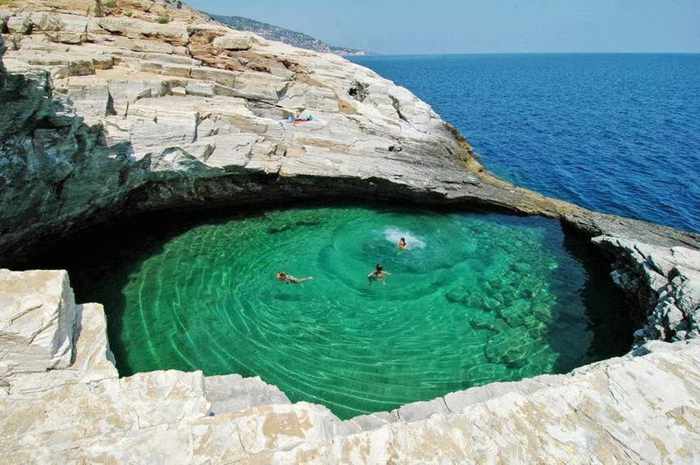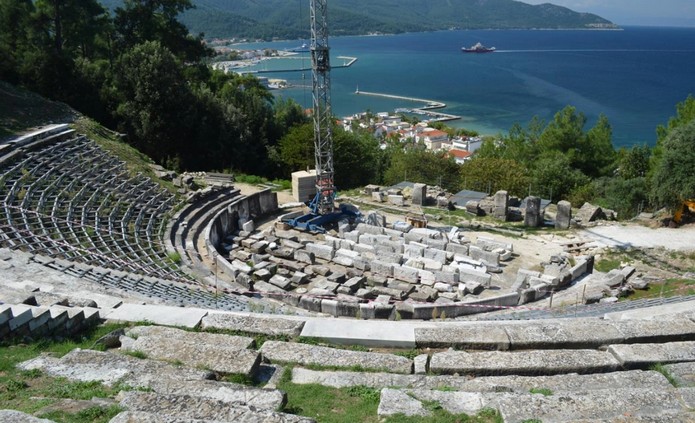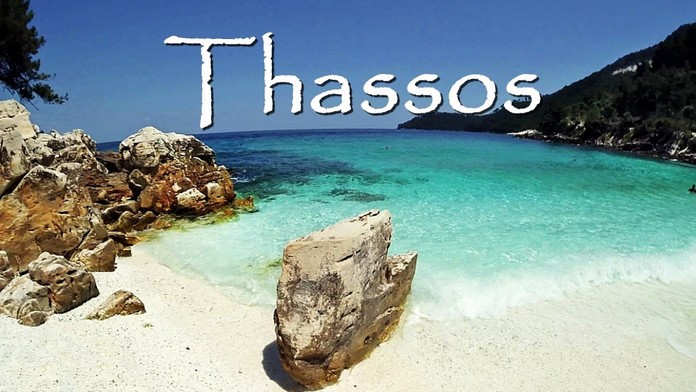Thassos is a large island with lofty pine trees. The pines are of a special kind with a white and perfectly straight trunk, good for the making of ship’s masts.
It lies 17 miles from Kavala in Macedonia and only 4 miles from Keramoti.
It’s a truly beautiful island with a high mountain, Psario (1203m) in the middle.
Thassos has rapidly grown into a large tourist center. A good paved road rings the island and the beaches, leading into the interior ending at picturesque villages.
This road network is also used by local buses which connect these villages to the coast and the capital of Thassos, Limenas.

All of this guarantees the visitor a comfortable and pleasant stay. Thassos is the northernmost island in the Aegean, with an area of 379 sq km, a coastline of 95km and population of 13000.
You reach Limenas by ferry boat from Kavala or Keramoti while Prinos, the second port of Thasos of Thasos opposite the oil wells, can be reached only from Kavala.
History
Thassos was already inhabited at the end of Neolithic period most probably by Thracians. At the beginning of the 7th century BC, Parians set off on an expedition to conquer the island. Their aim was the mineral wealth of Thassos, specifically the gold and marble. The Parians were successful and in the end conquered the island. The island began to flourish from that period. A colony was founded on the opposite coast.

The town of Thassos was fortified. It also developed commercial relations with Athens, Corinth, the Cyclades and Ionians. This prosperity was momentarily interrupted by Persian pillaging which the island suffered twice; in 490 BC when Darius tore down the walls of the town and in 480 BC under Xerxes.
During the Pelopponesian war the domination of the island alternated between Athens and Sparta. In 477 it became a part of the Delian alliance and in 340 BC it was occupied by the king of Macedonia, Philip II.
The island flourished under Roman rule in the 2nd and 1st century BC. Though the deposits of gold have been exhausted, Thassos still had wine and marble exports.
The long Byzantine period followed which was interrupted by the appearance of the Franks to be continued approximately 50 years later. The Gattiluci became the rulers of Thassos Staying on the island for about 40 years. The Turkish occupation lasted from 1460 to 1912 when Thassos was liberated and then united with Greece.
Limenas or Thassos
The capital of the island was built on the site of the ancient town with an idyllic bay , nestled in greenery. During the summer, this town, naturally, collects most of the visitors on the island.
The greatest amount of activity is late in the afternoon when the vacationers take their stroll or sit atb little tables in the harbour to enjoy the magnificent sunsets.
The archaeological space lies next to the harbour and is very close to the town’s houses.
East of this harbour are the ruins of a sanctuary of Poseidon , the sanctuary of Dionysos and the Agora.

Further east on the slope of a pine covered hill can be seen the ruins of a theatre (3rd century BC). This theatre, in which performances are still given in summer underwent alterations at the hands of the Romans. The acropolis commands the summit of the hill. The surviving walls are medieval and were built on the site of ancient walls.The descent from the acropolis can be made to the south-west, following the wall. In this case, the visitor will pass successively through the gate of Silenus, the Gate of Hercules and Dionysos and finally the gate of Zeus and Hera.
The ruins of the sanctuary of Hercules, the island’s protector, lie north of the Gate of Hercules and Dionysos. Near the ancient harbour is the Archaeological museum with noteworthy finds from the island.
Excursions
1. Limenas- Panayia- Potamia- Limenaria (54km)
3km. East of the port is the enchanting bay of Makryammos with a large hotel complex and a picturesque islet-rock on the right. Further on are the idyllic shores of Ay- Yiannis with the pine trees above the sea and the white marble.
7km. Panayia. A village where the houses have retained their traditional Macedonian style. Among its sites are the Church of the Panayia and Drakospilia. A turn left from the village leads to the famous Chrissi Ammos beach.
9km. Potamia. A village beneath the peak of Psarios, the highest mountain of Thassos surrounded by a lovely pine forest.
12km. Junction. From here a turn left leads to Chrisi Akti beach .
20km. Koinyra. A small settlement touristically developed in a peaceful and idyllic area with a like-named island. It serves as a link between the gorgeous rocks, the pine trees and the sea.
31km. Alyki. Nearby are ancient marble quarries. Further on, near Thymonia and on the steep slope of a mountain, is the monastery of Archangelos Michael, the island’s patron saint.
45km. Psili Ammos, Astrida. Two lovely summer settlements.
50km. Potos. A summer resort center. From here a turn right leads after 10km to Theologos, one of the most beautiful villages on Thassos with mansions and eminent churches.
54km. Limenaria. One of the largest tourist centers on Thassos with an enormous sand beach sheltered from the meltemi wind. Between Potos and LImenaria is Pefkari with an equally beautiful sand beach.
2. Limenas- Prinos- Skala- Marion- Limenaria (41km)
4km. Glyfada. A very picturesque bay with a sand beach. It attracts a lot of people because of its short distance from Limenas.
12km. Skala Rachoniou. A seaside settlement with a sand beach, the port of the village of Rachoni.
16km. Prinos. This is the port of Mikros and Megali Prinos which are in the interior. Prinos developed significantly after the discovery of oil and the drilling of oil wells in the sea near it. It also has a superb sand beach with pine trees.
21km. Skala Sotira. The port of Sotira with crystal clear water. Skala Kalirachis is nearby.
30km. Skala Marion. It’s in the southwest corner of Thassos and it’s the port of Marines which is 13km from there.
41km. Limenaria


